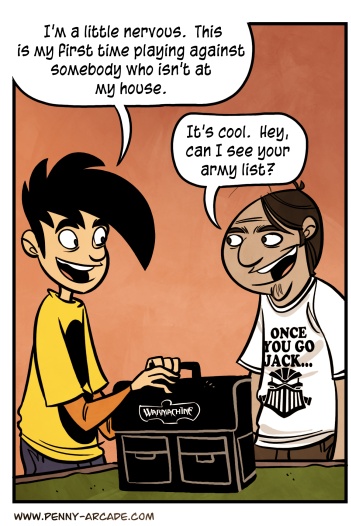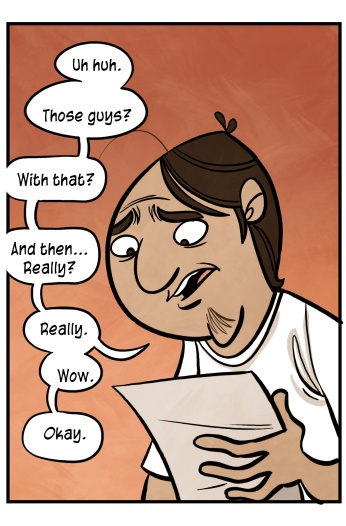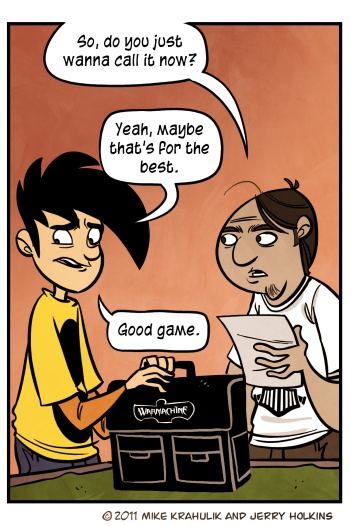This strip is less true than the one previous, because as much as we might be curious about getting our armies on some random table and smashing them together, I'm not sure we have it in us just yet. I'm not certain I'd feel entirely prepared until I had played n+1 games, where n equals the amount of games I could reasonably play during the rest of my life.
When Monday Night Combat was still in beta on the PC, I was watching the patch lists very carefully for evidence of mechanics changes. It had already received a sequence of major tuning updates by this time, so the thinking here should have been very far along already, and anything that wasn't an outright bug might give some hint as to what distinguished the PC from the console as a designer would see it. Then, I remembered that I could just interrogate him via email, and make a stranger write my post. Then, like so many other times, I was overwhelmed by my own genius.
<john.comes from Uber Entertainment>
Moving a shooter from the console to the PC has had some interesting challenges. Monday Night Combat is still the same game from a gameplay mechanics point of view. However, since the input mechanism has changed I have found some challenges in getting the game to a balanced state.
Now, ask any gamer who has played a shooter on both the PC and a console and they will tell you that mouse and keyboard is infinitely better than a console controller. PC players long for a game that they can play on a PC versus people playing on a console just for the pwnage of console newbie meat. We accept this as a universal truth. But why? Why is a mouse and keyboard so much better than a controller? Here’s my theory and analysis.
It all comes down to how each input mechanism affects your ability to turn. On a console, the angle in which a player can turn is a function of both time and displacement of the thumb stick. No matter how far players want to turn, they have to pay a time cost. Even at the highest controller sensitivity, there is a time cost to be paid. On a PC the angle of turn is a direct mapping of how far you move the mouse. The time cost is variable and the better players get that time cost to approach zero.
Now, on consoles we use an array of aim helping mechanisms all in an attempt to help with this time cost. View acceleration allows that time cost to not be linear from distance the thumb stick is moved. It’s an attempt to guess that if players jam their thumb stick to one side and hold it they want to spin quickly, but if they slam it to one side and release they want to make a fast minor adjustment. So at the beginning of the time cost the rate of turn is slower and it speeds up exponentially, to a cap, as time goes by.
View friction slows down the player’s turn speed when an enemy passes in front of their cursor. This makes it so they can shortcut that time cost by allowing players to turn up the sensitivity, thus lowering the time cost, but make it so that the turn rate slows down when you have an enemy in their sights. Hopefully, this makes it easier to get a target in the crosshairs.
View adhesion, which will cause the player’s cursor to adhere to enemies passing in front of the player, is an attempt at taking the time cost away. This mechanic tries to match the player’s turn rate to a target moving in front of the player. Thus trying to remove the time cost for moving targets that should be easily hit.
Aim attraction is the last console helping mechanism. This is a system that takes a shot you make, sees if it’s going to be close to a target, and adjust that shot ever so slightly so that it hits. This doesn’t directly affect the time cost but does give some perceived precision to shooting on a console.
Now, all these systems sound like cheating but they all revolve around the same concept; make the time to aim as small as possible. None of these systems are needed on the PC because that time can get to be nearly zero by sheer player skill.
With all that said, how does this affect Monday Night Combat from console to PC? Well, I take all the skills and abilities that are very aim dependent and look at them. The sniper is the most obvious example: a one shot, one kill class that is very powerful if their time to aim can be nearly zero. The first thing I did was drop the clip size of the sniper rifle by 60% (from 10 to 4). Why? Because now I’m forcing the sniper to be more accurate. On console I allowed for a little ‘slop’ and gave some extra ammo. But on PC the shots have to count or the player will find themselves vulnerable again while reloading. This may even get lower, since there is no kickback on our sniper rifle there’s even been talk of making it a bolt-action rifle.
The sniper was the first fix. The Tank charge was not as obvious at first. The skill is a one second forward run that damages, knocks back, and stuns anything it hits. On the console it works fine. Good players can use it to kill one other player. But now that there is a near-zero cost of aiming I found that good tanks can zig-zag to hit players or even easily charge around corners. So I dropped the damage of the level 3 Tank charge, which also does the stun, because I found that when players can aim that fast it becomes nearly impossible to avoid. With the damage so high it assured multiple kills. With the high damage the Tank Charge best use case on the console would be one kill but the best use case on the PC would be two or three kills.
Another subtle PC induced nerf was the Firebase. When a support player throws one out other players have three seconds to destroy it before it deployed and started attacking them. On the PC Firebases were dying much more often simply because players can focus on them so much faster. So to counter act this effect I reduced the amount of bonus damage they take while deploying. This forced players to focus on the Firebase for longer. This still make Firebases destroyable before they fully deployed but made it so it wasn’t so trivial.
Another interesting thing popped up recently. We were in the process of tweaking how the Gunner and Tank jump jets work. Why? Because with a mouse and keyboard, you can now jump and aim at the same time. With the console controller there's an additional time penalty to be paid to move your thumb off the jump button and back onto the right thumb stick in order to aim while jumping. This is no longer an issue on the keyboard so we looked at ways to slightly change the mechanic so the best move for the two heavy chassis was to always be in the air.
I’m sure as the Monday Night Combat beta goes on there will be more and more things I find that are affected by the precision of the mouse and keyboard controls. As I find them, we will fix them up and get them out to the fans as soon as possible.
</john.comes>
Generally speaking, console -> PC conversions don't have a good track record for being thoughtful, native experiences. I was curious about their process, and hopefully you were too, because that is a lot of text.
PAX East attendees (and those who hope to be), today is the very last day to register if you want to be considered for the Omegathon. Though I suppose that Consideration implies thought, when what I really do is wave a pen up and down over the list of pre-registrants and then call the person it falls on. If you would like an opportunity to be this person, to do battle with others selected in a similar fashion for a chance to go to GamesCom with friend of yours, today is the day.
(CW)TB out.



